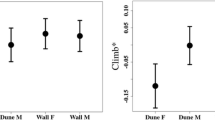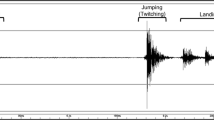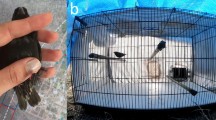Abstract
Ornaments are believed to signal an individual's ability to reproduce successfully and/or survive. Since an individual's fitness is often influenced by multiple traits (e.g. number of copulations, ability to acquire nest sites or to escape predators), which are difficult to quantify simultaneously, we examine performance traits (bite force, jumping performance) believed to be relevant to an individual's fitness. Specifically, we ask whether variation in dewlap size is related to variation in body size, bite force and jumping ability in the lizard Anolis carolinensis. Our results show that dewlap size is correlated with jumping capacity across all individuals, whereas the relationships between dewlap size, body size and bite force differ depending on sex/age class. We argue that selection against relatively large dewlaps at the transition between small mature and large mature males might be responsible for the lack of a relationship within large males. The absence or presence of a correlation between dewlap size and bite force, on the other hand, might be explained by differences in behaviour, such as territory establishment, anti-predator tactics, and/or mate choice. Our work thus suggests that selective forces influencing the evolution of ornaments may operate differently on different sexes and life-history stages.




Similar content being viewed by others
References
Andrews RM (1985) Mate choice by females of the lizard, Anolis carolinensis. J Herpetol 29:284–289
Arnold SJ (1983) Morphology, performance and fitness. Am Zool 23:347–361
Bels V (1990) The mechanism of dewlap extension in Anolis carolinensis (Reptilia: Iguanidae) with histological analysis of the hyoid apparatus. J Morphol 206:225–244
Blanco G, De La Puente J (2002) Multiple elements of the black-billed magpie's tail correlate with variable honest information on quality in different age/sex classes. Anim Behav 63:217–225 DOI10.1006/anbe.2001.1909
Clark DR, Kroll JC (1974) Thermal ecology of anoline lizards: temperate versus tropical strategies. Southwest Nat 19:9–19
Crews D (1975) Effects of different components of male courtship behaviour on environmentally induced ovarian recrudescence and mating preferences in the lizard, Anolis carolinensis. Anim Behav 23:349–356
Darwin C (1871) The descent of man, and selection in relation to sex. John Murray, London
DeCourcy KR, Jenssen TA (1994) Structure and use of male territorial headbob signals by the lizards Anolis carolinensis. Anim Behav 47:251–262
Echelle AF, Echelle AA, Fitch HS (1978) Inter-and intraspecific allometry in a display organ: the dewlap of Anolis (Iguanidae) species. Copeia 1978:245–250
Ellers J, Boggs CL (2003) The evolution of wing color: male mate choice opposes adaptive wing color divergence in Collas butterflies. Evolution 57:1100–1106
Emerson SB, Arnold SJ (1989) Intraspecific and interspecific relationships between morphology, performance and fitness. In: Wake DB, Roth G (eds) Complex organismal functions: integration and evolution in vertebrates. Wiley, New York, pp 295–314
Endler JA (1986) Natural selection in the wild. Princeton University Press, Princeton, NJ
Fairbairn DJ, Reeve JP (2001) Natural selection. In: Fox CW, Roff DA, Fairbairn DJ (eds) Evolutionary ecology: concept and case studies. Oxford University Press, Oxford, pp 29–43
Ferns PN, Hinsley SA (2004) Immaculate tits: head plumage pattern as an indicator of quality in birds. Anim Behav 67:261–272, DOI10.1016/j.anbehav.2003.05.006
Fitch HS, Hillis DM (1984) The Anolis dewlap: interspecific variability and morphological associations with habitat. Copeia 1984:315–325
Forsman A, Appelqvist S (1999) Experimental manipulation reveals differential effects of colour pattern on survival in male and female pygmy grasshoppers. J Evol Biol 12:391–401
Garland TJr, Hankins E, Huey RB (1990) Locomotor capacity and social dominance in male lizards. Funct Ecol 4:243–250
Garland TJr, Losos JB (1994) Ecological morphology of locomotor performance in squamate reptiles. In: Wainwright PC, Reilly SM (eds) Ecological morphology. University of Chicago Press, Chicago, pp 240–302
Gomez JM (2004) Bigger is not alwys better: conflicting selective pressures on seed size in Quercus ilex. Evolution 58:71–70
Greenberg B, Noble GK (1944) Social behavior of the American chameleon (Anolis carolinensis Voigt). Physiol Zool 17:392–439
Grether GF (1996) Intrasexual competition alone favors a sexually dimorphic ornament in the rubyspot damselfly Hetaerina americana. Evolution 50:1949–1957
Hamlett GWD (1952) Notes on breeding and reproduction in Anolis carolinensis. Copeia 1952:183–185
Hartigan JA, Hartigan PM (1985) The dip test of unimodality. Ann Stat 13:70–84
Hartigan PM (1985) Computation of the Dip Statistic to test for unimodality. Appl Stat 34:320–325
Herrel A, Spithoven L, Van Damme R, De Vree F (1999) Sexual dimorphism of head size in Gallotia galloti: testing the niche divergence hypothesis by functional analysis. Funct Ecol 13:289–297
Irschick DJ, Garland TJr (2001) Integrating function and ecology in studies of adaptation: investigations of locomotor capacity as a model system.Annu Rev Ecol Syst 32:367–396
Irschick DJ, Losos JB (1998) A comparative analysis of the ecological significance of maximal locomotor performance in Caribbean Anolis lizards. Evolution 52:219–226
Jenssen TA (1977) Evolution of anoline lizard display behavior. Am Zool 17:203–215
Jenssen TA, Orrell KS, Lovern MB (2000) Sexual dimorphisms in aggressive signal structure and use by a polygynous lizard, Anolis carolinensis. Copeia 2000:140–149
Kruuk LEB, Slate J, Pemberton JM, Brotherstone S, Guinness F, Clutton-Brock T (2002) Antler size in red deer: heritability and selection but no evolution. Evolution 56:1683–1695
Lailvaux S, Herrel A, Vanhooydonck B, Meyers J, Irschick DJ (2004) Performance capacity, fighting tactics, and the evolution of life-stage morphs in the green anole lizard (Anolis carolinensis). Proc R Soc Lond B 271:2501–2508
Leal M (1999) Honest signalling during prey-predator interactions in the lizard Anolis cristatellus. Anim Behav 58:521–526
Leal M, Rodriguez-Robles JA (1995) Antipredator responses of Anolis cristatellus (Sauria: Polychrotidae). Copeia 1995:155–161
Leal M, Rodriguez-Robles JA (1997a) Antipredator responses of the Puerto Rican anole Anolis cuvieri (Squamata: Polychrotidae). Biotropica 29:372–375
Leal M, Rodriguez-Robles JA (1997b) Signalling displays during predator-prey interactions in a Puerto Rican anole, Anolis cristatellus. Anim Behav 54:1147–1154
Losos JB, Chu L (1998) Examination of factors potentially affecting dewlap size in Caribbean anoles. Copeia 1998:430–438
Losos JB, Irschick DJ (1996) The effect of perch diameter on escape behaviour of Anolis lizards: laboratory predictions and field tests. Anim Behav 51:593–602
Lovern MB, Jenssen TA (2001) The effects of context, sex, and boy size on staged social interactions in juvenile male and female green anoles (Anolis carolinensis). Behaviour 138:1117–1135
Lovern MB, Jenssen TA, Orrell KS, Tuchak T (1999) Comparisons of temporal display structure across contexts and populations in male Anolis carolinensis: signal stability or lability? Herpetologica 55:222–234
Maynard Smith J, Harper D (2003) Animal signals. Oxford University Press, Oxford
McMann S (1993) Contextual signalling and the structure of dyadic encounters in Anolis carolinensis. Anim Behav 46:657–668
Møller AP (1988a) Paternity and paternal care in the swallow, Hirundo rustica. Anim Behav 36:996–1005
Møller AP (1988b) Badge size in the house sparrow Passer domesticus. Effects of intra- and intersexual selection. Behav Ecol Sociobiol 22:373–378
Møller AP, Nielsen JT (1997) Differential predation cost of a secondary sexual character: sparrowhawk predation or barn swallows. Anim Behav 54:1545–1551
Nunez SC, Jenssen TA, Ersland K (1997) Female activity profile of a polygynous lizard (Anolis carolinensis): evidence of intersexual asymmetry. Behaviour 134:205–223
Orrell KS, Jenssen TA (2003) Heterosexual signalling by the lizard Anolis carolinensis, with intersexual comparisons across contexts. Behaviour 140:603–634
Perry G, Levering K, Girard I, Garland TJr (2004) Locomotor performance and dominance in male Anolis cristatellus. Anim Behav 67:37–47 DOI 10.1016/j.anbehav.2003.02.003
Preziosi RF, Fairbairn DJ (2000) Lifetime selection on adult body size and components of body size in a waterstrider: opposing selection and maintenance of sexual size dimorphism. Evolution 54:558–566
Pryke SR, Andersson S, Lawes MJ (2001) Sexual selection of multiple handicaps in the red-collared widowbird: female choice of tail length but not carotenoid display. Evolution 55:1452–1463
Robson MA, Miles DB (2000) Locomotor performance and dominance in tree lizards, Urosaurus ornatus. Funct Ecol 14:338–344
Saino N, Bolzern AM, Møller AP (1997) Immunocompetence, ornamentation, and viability of male barn swallows (Hirundo rustica). Proc Natl Acad Sci USA 94:549–552
Stamps JA (1983) Sexual selection, sexual dimorphism, and territoriality. In: Huey RB, Pianka ER, Schoener TW (eds) Lizard ecology: studies of a model organism. Harvard University Press, Cambridge, pp 169–204
Stamps JA, Krishnan VV (1997) Functions of fights in territory establishment. Am Nat 150:393–405
Stamps JA, Krishnan VV (1998) Territory acquisition in lizards. IV. Obtaining high status and exclusive home ranges. Anim Behav 55:461–472
Stone PA, Snell HL, Snell HM (2003) Island biogeography of morphology and social behavior in the lava lizards of the Galapagos Islands. In: Fox SF, McCoy JK, Baird TA (eds) Lizard social behavior. Johns Hopkins University Press, Baltimore, MD, pp 190–239
Tokarz RR, Paterson AV, McMann S (2003) Laboratory and field test of the functional significance of the male's dewlap in the lizard Anolis sagrei. Copeia 2003:502–511
Toro E, Herrel A, Vanhooydonck B, Irschick DJ (2003) A biomechanical analysis of intra- and interspecific scaling of jumping and morphology in Caribbean Anolis lizards. J Exp Biol 206:2641–2652 DOI 10.1242/jeb.00473
Vanhooydonck B, Van Damme R (2003) Relationships between locomotor performance, microhabitat use and antipredator behaviour in lacertid lizards. Funct Ecol 17:160–169
Vanhooydonck B, Herrel A, Van Damme R, Irschick DJ (2005) Does dewlap size predict male bite performance in Jamaican Anolis lizards? Funct Ecol 19:38–42
Veiga JP (1993) Badge size, phenotypic quality, and reproductive success in the house sparrow: a study on honest advertisement. Evolution 47:1161–1170
Verwaijen D, Van Damme R, Herrel A (2002) Relationships between head size, bite force, prey handling efficiency and diet in two sympatric lacertid lizards. Funct Ecol 16:842–850
Williams EE, Rand AS (1977) Species recognition, dewlap function and faunal size. Am Zool 17:261–270
Acknowledgements
This work was supported by an NSF grant to DJI (IBN 9983003). BV and AH are postdoctoral fellows at the Fund for Scientific Research Flanders (FWO-Vl). All experimental protocols were approved by the Institutional Animal Care and Use Committee of Tulane and Antwerp University.
Author information
Authors and Affiliations
Corresponding author
Additional information
Communicated by S. Downes
Appendix
Appendix
Directional selection, quantity i, is calculated using Eq. 1; stabilizing (if negative) and disruptive selection (if positive), both quantity j, are calculated using Eq.2 (Endler 1986).
where\(\bar x_{\rm a}\) is the mean value in trait × after selection; \(\bar x_{\bf b}\) the mean value in trait × before selection; v a the variance in trait × after selection; v b the variance in trait × before selection.
The statistical significance of directional selection, i, is tested using Eq. 3; the statistical significance of stabilizing or disruptive selection, j, is tested using Eq. 4 (Endler 1986).
where N a is the sample size after selection; N b the sample size before selection; and N=N a+N b.
Rights and permissions
About this article
Cite this article
Vanhooydonck, B., Herrel, A., Van Damme, R. et al. The relationship between dewlap size and performance changes with age and sex in a Green Anole (Anolis carolinensis) lizard population. Behav Ecol Sociobiol 59, 157–165 (2005). https://doi.org/10.1007/s00265-005-0022-y
Received:
Revised:
Accepted:
Published:
Issue Date:
DOI: https://doi.org/10.1007/s00265-005-0022-y




